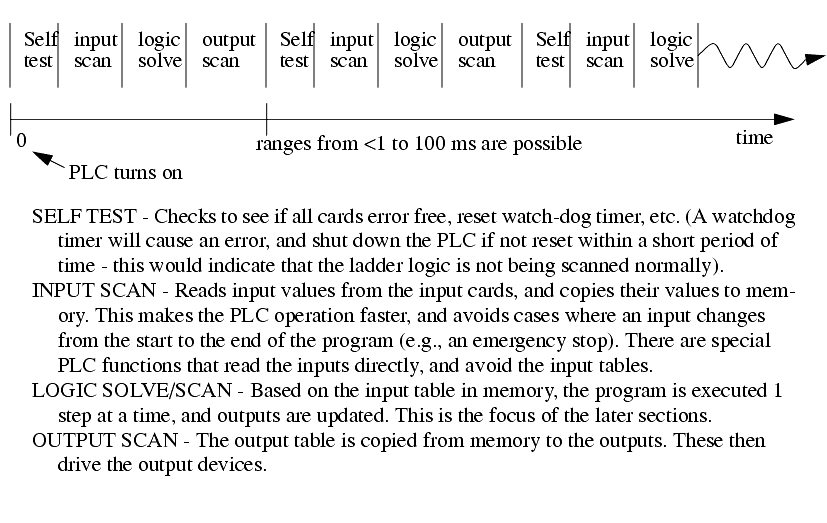
|
|
|
8.2 OPERATION SEQUENCE
������������All PLCs have four basic stages of operations that are repeated many times per second. Initially when turned on the first time it will check it's own hardware and software for faults. If there are no problems it will copy all the input and copy their values into memory, this is called the input scan. Using only the memory copy of the inputs the ladder logic program will be solved once, this is called the logic scan. While solving the ladder logic the output values are only changed in temporary memory. When the ladder scan is done the outputs will updated using the temporary values in memory, this is called the output scan. The PLC now restarts the process by starting a self check for faults. This process typically repeats 10 to 100 times per second as is shown in Figure 91.

The input and output scans often confuse the beginner, but they are important. The input scan takes a snapshot of the inputs, and solves the logic. This prevents potential problems that might occur if an input that is used in multiple places in the ladder logic program changed while half way through a ladder scan. Thus changing the behaviors of half of the ladder logic program. This problem could have severe effects on complex programs that are developed later in the book. One side effect of the input scan is that if a change in input is too short in duration, it might fall between input scans and be missed.
When the PLC is initially turned on the normal outputs will be turned off. This does not affect the values of the inputs.
8.2.1 The Input and Output Scans
������������When the inputs to the PLC are scanned the physical input values are copied into memory. When the outputs to a PLC are scanned they are copied from memory to the physical outputs. When the ladder logic is scanned it uses the values in memory, not the actual input or output values. The primary reason for doing this is so that if a program uses an input value in multiple places, a change in the input value will not invalidate the logic. Also, if output bits were changed as each bit was changed, instead of all at once at the end of the scan the PLC would operate much slower.
8.2.2 The Logic Scan
������������Ladder logic programs are modelled after relay logic. In relay logic each element in the ladder will switch as quickly as possible. But in a program elements can only be examines one at a time in a fixed sequence. Consider the ladder logic in Figure 92, the ladder logic will be interpreted left-to-right, top-to-bottom. In the figure the ladder logic scan begins at the top rung. At the end of the rung it interprets the top output first, then the output branched below it. On the second rung it solves branches, before moving along the ladder logic rung.
The logic scan sequence become important when solving ladder logic programs which use outputs as inputs, as we will see in Chapter 8. It also becomes important when considering output usage. Consider Figure 93, the first line of ladder logic will examine input A and set output X to have the same value. The second line will examine input B and set the output X to have the opposite value. So the value of X was only equal to A until the second line of ladder logic was scanned. Recall that during the logic scan the outputs are only changed in memory, the actual outputs are only updated when the ladder logic scan is complete. Therefore the output scan would update the real outputs based upon the second line of ladder logic, and the first line of ladder logic would be ineffective.

Search for More: |

Custom Search
|

|